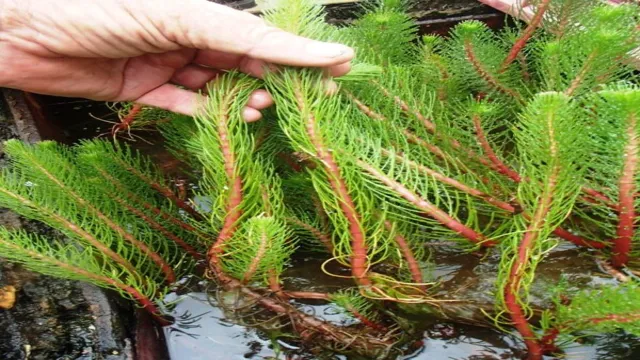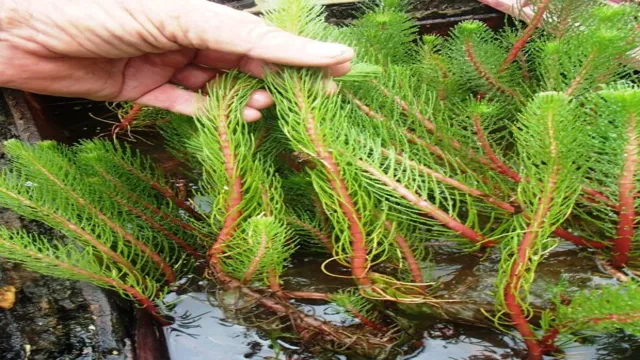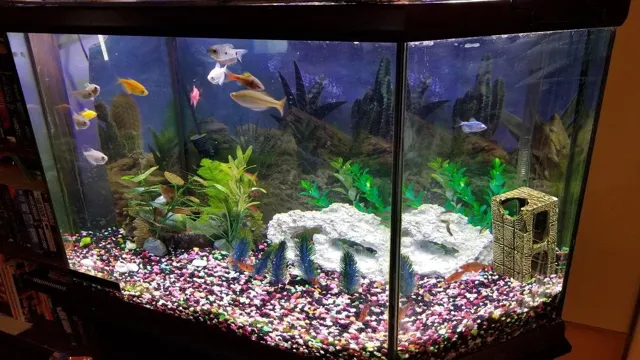Looking to add some greenery to your aquarium? Foxtail plants are a popular choice amongst fish keepers due to their unique appearance and easy care requirements. These plants can grow quite tall, making them ideal for taller aquariums, but how tall can they actually get? And what kind of care do they need? In this post, we’ll cover all you need to know about aquarium foxtail plants, from their height to their care requirements, so you can decide if they’re the right fit for your underwater oasis. So, let’s dive in!
Introduction
Aquarium foxtail plants are a popular choice for freshwater tanks due to their lush green appearance and ease of care. Many aquarium hobbyists wonder how tall these plants can grow, as it can impact the overall layout and design of the tank. Generally, foil tail plants will grow to a height of six to eight inches, making them perfect for smaller tanks or as foreground plants in larger setups.
With proper lighting, nutrients, and trimming, they can become bushy and full, creating a beautiful underwater landscape. Additionally, foxtail plants do well when planted in groups, enhancing their aesthetic appeal and providing shelter for fish and other aquatic creatures. Overall, foxtail plants are a versatile and stunning addition to any aquarium, with their size and growth rate making them an ideal choice for both novice and experienced aquarists.
Description of Aquarium Foxtail Plants
Aquarium foxtail plants are a popular choice among aquarists for their feathery and lush appearance, as well as their ability to provide natural hiding spaces for fish. These plants belong to the Ceratophyllum genus and are native to various regions in the world, including Africa, Europe, and Asia. Their unique shape is due to their needle-like leaves that are arranged in a spiral pattern.
This creates a dense and fluffy appearance that gives the aquarium a natural, vibrant look. Foxtail plants are also great oxygenators, absorbing CO2 and other pollutants while releasing oxygen into the water, creating a healthy environment for aquatic life. Overall, if you’re looking to add some greenery to your aquarium while enhancing the health of your aquatic pets, then aquarium foxtail plants may be a suitable choice for you.

Appearance and Characteristics
When it comes to appearance and characteristics, each living being has its unique set of features that distinguish it from others. Animals, in particular, exhibit a wide range of traits that make them stand out. Some animals have distinct patterns on their fur or skin, while others have unusual shapes or sizes.
At the same time, animals have varying behaviors that define their characteristics. For instance, some animals are nocturnal and prefer to stay up at night, while others are diurnal and active during the day. Each animal’s unique appearance and characteristics play an essential role in its adaptation and survival in its specific environment.
As such, studying animals’ characteristics and appearance can give us valuable insights into their behavior and ecology, enabling us to develop better conservation strategies to protect them and their habitats.
Growth and Height
Aquarium foxtail plants are known for their rapid growth and graceful appearance. They can grow up to 12 inches in height and will keep on growing as long as there is enough lighting and fertilization. Although they can adapt to low lighting conditions, it is essential to provide them with moderate to high lighting to help them reach their full potential.
With the right care, they can quickly fill up the space within your aquarium in no time. However, it is crucial to prune them regularly to prevent them from taking over the aquarium and blocking out other plants’ access to light. In conclusion, if you are looking for a plant that can quickly develop and add beauty to your aquarium, then the aquarium foxtail plant is an excellent choice.
Ideal Conditions for Growth
When it comes to growth and height, there are certain ideal conditions that can help foster this development. First and foremost, proper nutrition is crucial. Eating a balanced diet that includes enough protein, calcium, and vitamin D is essential for bone growth and strength. (See Also: How to Kill Duckweed in Aquarium: Effective Strategies and Tips)
Additionally, regular physical activity is important for building strong muscles and promoting growth. It’s also important to get enough sleep, as this is when the body does a lot of its growth and repair work. Genetics also play a role in determining height, but focusing on these environmental factors can help ensure that you’re giving yourself the best chance for optimal growth.
So, make sure to eat well, stay active, and get plenty of rest to help your body reach its full potential.
Average Height of Aquarium Foxtail Plants
Aquarium Foxtail plants are an ideal choice for planted aquarium enthusiasts looking to add some lush greenery to their tank. With proper care, these plants can grow quite tall, reaching up to 20 inches in height. However, the average height of an Aquarium Foxtail plant is around 10 to 15 inches.
The growth rate of these plants largely depends on the amount of light, nutrients and CO2 available in the tank. With adequate amounts of these factors, the growth rate can be quite rapid, and the plants can quickly take over the entire tank. It is essential to give these plants enough space to grow and trim them regularly to ensure they stay healthy and do not overshadow other plants in the aquarium.
Overall, the Aquarium Foxtail plant is an excellent addition to any planted aquarium, providing a lively and natural-looking environment for your aquatic pets.
Care and Maintenance
Aquarium foxtail plants are a popular choice for aquarium enthusiasts due to their strikingly bright green feathery foliage. These plants can grow up to 12 inches in height and can quickly spread outwards, creating a dense and lush underwater garden. To ensure that your foxtail plants thrive, it’s important to provide them with a nutrient-rich substrate and adequate lighting conditions.
These plants also require consistent cleaning and maintenance to prevent algae buildup and ensure that their growth is not hindered. You can trim the foxtail plants as needed to prevent overcrowding and promote healthy growth. With proper care and maintenance, your aquarium foxtail plants can reach their full potential and create a stunning aquatic landscape.
Nutrition and Fertilization
Taking care of plants and ensuring their growth and development requires proper nutrition and fertilization. Just like humans, plants need essential nutrients, such as nitrogen, phosphorus, and potassium, to thrive. That’s why it’s crucial to fertilize your plants regularly to ensure they’re getting enough of these vital elements.
However, over-fertilizing can also be harmful to your plants, so it’s crucial to follow the instructions and use the correct amount of fertilizer. In addition to fertilization, watering your plants regularly is also crucial, but it’s important not to overwater them as it can cause root rot and kill your plants. Providing your plants with adequate light and caring for them properly, such as pruning and trimming, can also help them grow and mature. (See Also: How to Make Plant for Aquarium: A Step-by-Step Guide for Beginners)
By taking care of your plants and providing them with proper nutrition and fertilization, you can ensure that they’ll thrive and beautify your home or garden.
Lighting and Temperature Requirements
Caring for your indoor plants can be a rewarding experience, but it’s vital to understand their lighting and temperature requirements to help them thrive. Each plant has different lighting needs, and it’s essential to consider their natural habitat when choosing their location. Some plants love bright indirect sunlight, while others prefer low light conditions, so ensure you know what each of your plants needs.
Additionally, temperature is a crucial factor, and keeping your plants away from drafts, cold windows, and fluctuations in temperature is vital. It’s also a good idea to keep the temperature consistent, so your plants don’t experience stress and can grow normally. Remember, just like people, plants can be affected by temperature and lighting changes, so it’s crucial to keep them in a stable environment that mimics their natural habitat for optimal growth and wellbeing.
Pruning and Propagation
When it comes to caring for your plants, proper pruning and propagation techniques are vital for maintaining their health and promoting growth. Pruning, which involves removing dead or damaged branches, as well as shaping the plant, helps to encourage new growth and prevents disease. To properly prune your plants, start by selecting the right tools for the job, such as pruning shears or a pruning saw.
Then, remove any damaged, diseased, or dead branches by cutting at a 45-degree angle just above a healthy bud or branch. Additionally, you can promote bushier growth by making a V-cut above a bud or branch. Propagation, on the other hand, involves creating new plants from cuttings of existing plants.
This is a great way to expand your garden without having to buy new plants. To propagate your plants, take a cutting from a healthy stem, ensuring that it has a few leaves and at least one node where the roots will form. Plant the cutting in a soilless mix, keeping it moist and warm until the roots have formed.
With proper pruning and propagation, your plants will thrive and provide you with a beautiful, healthy garden for years to come.
Conclusion
Well, after a deep dive into the depths of the aquatic world, it seems that aquarium foxtail plants have a growth potential that’s nothing to scoff at. From their humble beginnings as tiny fibers, these majestic plants can reach heights of up to 12 inches or more. But, as with all things in life, their growth is ultimately determined by the environment in which they’re placed.
So, whether you want a towering centerpiece or a modest addition to your underwater oasis, it’s all about finding the right balance and giving your foxtail plant the love and care it deserves. Happy planting, folks!”
FAQs
What is the ideal water temperature for growing aquarium foxtail plants?
The ideal water temperature for growing aquarium foxtail plants is between 72°F to 82°F.
(See Also: How to Cycle Your New Aquarium: A Step-by-Step Guide for Beginners)
Can aquarium foxtail plants survive in low light conditions?
Yes, aquarium foxtail plants can survive in low light conditions, but they may not grow as quickly as they would in higher light conditions.
Are aquarium foxtail plants easy to care for?
Yes, aquarium foxtail plants are generally considered easy to care for. They require regular water changes and trimming to maintain their shape.
How often should aquarium foxtail plants be trimmed?
Aquarium foxtail plants should be trimmed every few weeks to promote healthy growth and prevent them from becoming too bushy.
Can aquarium foxtail plants be propagated?
Yes, aquarium foxtail plants can be propagated by cutting off a stem and replanting it in the substrate.
Do aquarium foxtail plants have any special requirements for fertilization?
Aquarium foxtail plants benefit from regular fertilization with a balanced aquarium plant fertilizer.
How tall do aquarium foxtail plants typically grow?
Aquarium foxtail plants can grow up to 6-8 inches tall, depending on the conditions in the aquarium.







